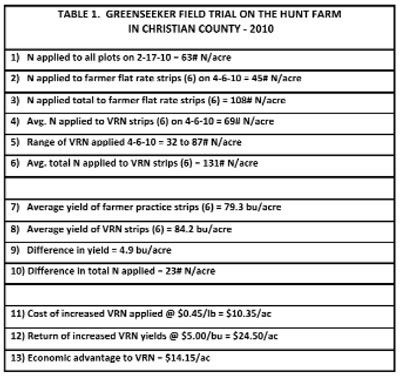Variable Rate Nitrogen (VRN) Application On Wheat Using The Greenseeker On A Field Basis
PRINCETON, KY.
The objective of this experiment
is to determine if
the algorithms for variable
rate nitrogen applications
found from small plot
research in Kentucky will result
in improved nitrogen applications
and yield when
plant sensors are used on a
commercial applicator in a large wheat field.
The Greenseeker is a real-time, on-the-go sensor/
applicator that senses the health of the
wheat crop at the time nitrogen is applied and
then simultaneously adds the precise amount
of nitrogen that is determined to be needed by
the machine. The sensing and application technology
part of the machine has been very accurate
and reliable. The weak part of the process
has been the algorithm (formula) that is placed
in the software of the machine to tell it how
much nitrogen to add based on the plant health
Normalized Difference Vegetation Index (NDVI)
readings. Basic field research has resulted in reliable
algorithms for use on field application.
METHODS
A replicated (6 replications) field trial in Christian
County was done with the Greenseeker in a
large field with the help of Brandon Hunt,
Phillip Needham and Jason Head. The Hunt
farms bought 4 Greenseeker units and placed
them on a sprayer with a 60 foot boom. The
Greenseeker units were assembled to give an
average NDVI reading across the 60 foot boom
and N rates changed across the entire boom as
called for by the NDVI readings. The 2008 algorithm
was used for this trial. The sprayer only
used pressure to change 32 percent VRN solution
volume So the change was limited to a 50
lb/a N range (30 to 80 lb/ac N) and the rate of
change was slow, especially at 12 mph.

RESULTS
The N rate used by the Greenseeker averaged
23 lb/ac N higher than the farmer practice, flat
rate chosen by the Hunts and the wheat consultant.
The visual observations beginning
about 2 weeks after the N application showed
the Greenseeker plots to be greener with less
color differences within the stripes. They definitely
looked a little better.
The final yields showed the Greenseeker plots
to yield about 5 bu/acre more. This statistically
significant increased yield could be due to a better
N distribution, a higher N rate or a combination.
Table 1 gives the specifics of N
application and the yield. The economics in the
Table show about a $14/acre advantage for the
use of the Greenseeker not considering the cost
of the initial investment. Δ
DR. LLOYD MURDOCK: Extension Soils Specialist,
University of Kentucky